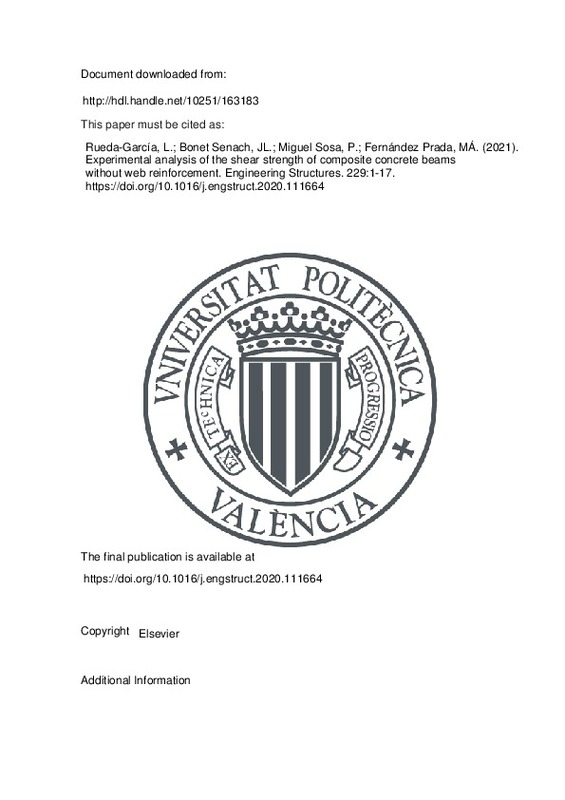Ribas González, C. R., & Fernández Ruiz, M. (2017). Influence of flanges on the shear-carrying capacity of reinforced concrete beams without web reinforcement. Structural Concrete, 18(5), 720-732. doi:10.1002/suco.201600172
Loov, R. E., & Patnaik, A. K. (1994). Horizontal Shear Strength of Composite Concrete Beams With a Rough Interface. PCI Journal, 39(1), 48-69. doi:10.15554/pcij.01011994.48.69
Kovach J, Naito C. Horizontal shear capacity of composite concrete beams without interface ties. ATLSS Report No. 05-09; 2008.
[+]
Ribas González, C. R., & Fernández Ruiz, M. (2017). Influence of flanges on the shear-carrying capacity of reinforced concrete beams without web reinforcement. Structural Concrete, 18(5), 720-732. doi:10.1002/suco.201600172
Loov, R. E., & Patnaik, A. K. (1994). Horizontal Shear Strength of Composite Concrete Beams With a Rough Interface. PCI Journal, 39(1), 48-69. doi:10.15554/pcij.01011994.48.69
Kovach J, Naito C. Horizontal shear capacity of composite concrete beams without interface ties. ATLSS Report No. 05-09; 2008.
Fang, Z., Jiang, H., Liu, A., Feng, J., & Chen, Y. (2018). Horizontal Shear Behaviors of Normal Weight and Lightweight Concrete Composite T-Beams. International Journal of Concrete Structures and Materials, 12(1). doi:10.1186/s40069-018-0274-3
ACI Committee 318. Building code requirements for structural concrete (ACI 318-19); and commentary (ACI 318R-19). Farmington Hills: American Concrete Institute; 2019.
Marí, A., Cladera, A., Bairán, J., Oller, E., & Ribas, C. (2014). Shear-flexural strength mechanical model for the design and assessment of reinforced concrete beams subjected to point or distributed loads. Frontiers of Structural and Civil Engineering, 8(4), 337-353. doi:10.1007/s11709-014-0081-0
Avendaño AR, Bayrak O. Shear strength and behaviour of prestressed concrete beams. Technical Report: IAC-88-5DD1A003-3, Texas Department of Transportation; 2008.
Fédération International du Béton (fib). Model Code 2010. Ernst & Sohn; 2012.
CEN. EN 1992-1-1:2004. Eurocode 2: Design of concrete structures - Part 1-1: General rules and rules for buildings; 2004.
Halicka, A., & Jabłoński, Ł. (2016). Shear failure mechanism of composite concrete T-shaped beams. Proceedings of the Institution of Civil Engineers - Structures and Buildings, 169(1), 67-75. doi:10.1680/stbu.14.00127
Halicka, A. (2011). Influence new-to-old concrete interface qualities on the behaviour of support zones of composite concrete beams. Construction and Building Materials, 25(10), 4072-4078. doi:10.1016/j.conbuildmat.2011.04.045
Swamy, R. N., Andriopoulos, A., & Adepegba, D. (1970). Arch Action and Bond in Concrete Shear Failures. Journal of the Structural Division, 96(6), 1069-1091. doi:10.1061/jsdeag.0002596
Rueda-García L, Bonet Senach JL, Miguel Sosa PF. Influence of interface roughness and shear reinforcement ratio in vertical shear strength of composite concrete beams. In: ACHE, editor. VIII Congr. la Asoc. Española Ing. Estructural, ACHE, Santander; 2020.
UNE-EN 12390-3:2020. Testing hardened concrete - Part 3: Compressive strength of test specimens; 2020.
UNE-EN 12390-6:2010. Testing hardened concrete - Part 6: Tensile splitting strength of test specimens; 2010.
UNE-EN 12390-13:2014. Testing hardened concrete - Part 13: Determination of secant modulus of elasticity in compression; 2014.
UNE-EN ISO 6892-1:2017. Metallic materials - Tensile testing - Part 1: Method of test at room temperature; 2017.
Fernández Ruiz, M., Muttoni, A., & Sagaseta, J. (2015). Shear strength of concrete members without transverse reinforcement: A mechanical approach to consistently account for size and strain effects. Engineering Structures, 99, 360-372. doi:10.1016/j.engstruct.2015.05.007
Ayensa, A., Oller, E., Beltrán, B., Ibarz, E., Marí, A., & Gracia, L. (2019). Influence of the flanges width and thickness on the shear strength of reinforced concrete beams with T-shaped cross section. Engineering Structures, 188, 506-518. doi:10.1016/j.engstruct.2019.03.057
Swamy, R. N., & Qureshi, S. A. (1974). An ultimate shear strength theory for reinforced concrete T-beams without web reinforcement. Matériaux et Constructions, 7(3), 181-189. doi:10.1007/bf02473833
[-]







![[Cerrado]](/themes/UPV/images/candado.png)


